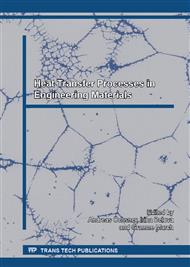p.73
p.83
p.91
p.97
p.103
p.111
p.121
p.129
p.135
Influence of Corrosive Environment on Changes of the ZnAl40Cu3 Upper Alloy Layer
Abstract:
Zn-Al alloys are used mainly because of their tribological properties as a material alternative to bronze, cast iron and aluminum alloys in bearings, and as a structural material. Improved properties of Zn-Al alloys can be obtained by the addition of copper , silicon and using of heat treatment. Tribological properties of alloys of the Zn-Al-Cu alloys, their structure has been well described in the literature. Far less are, however, studies on the effect of corrosive environments on the structure of the surface layer of the alloy. The purpose of this examination was to determine the effect of corrosive environment on the surface layer of the ZnAl22Cu3 alloy. Subject of examination was the unmodified alloy containing 40% Al mass. and 3%. Cu (Zn - remain). The tested alloy was subject of the following operations: soaking at the temperature of 185°C during 10 hours with cooling in water, soaking at the temperature of 380°C during 10 hours with cooling in water and soaking at the temperature of 380°C w during10 hours with subsequent soaking at the temperature of 170°C with cooling in water. Subject of tests structural examination were samples after potentiostatic tests carried out at potential E = 300 mV Ekor in 24 hours in an acid rain, pH = 3.5. In order to determine the microstructure of the examined coatings metallographic examinations were performed using optical and scanning microscope cooperating with EDS X-ray spectrometer. Quantitative analysis of the selected characteristic microareas determined from X-ray spectral analysis EDX.
Info:
Periodical:
Pages:
103-109
Citation:
Online since:
March 2013
Authors:
Keywords:
Price:
Сopyright:
© 2013 Trans Tech Publications Ltd. All Rights Reserved
Share:
Citation:


